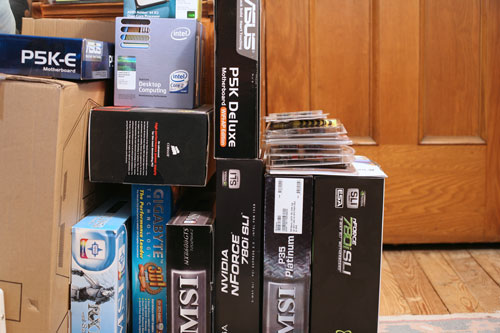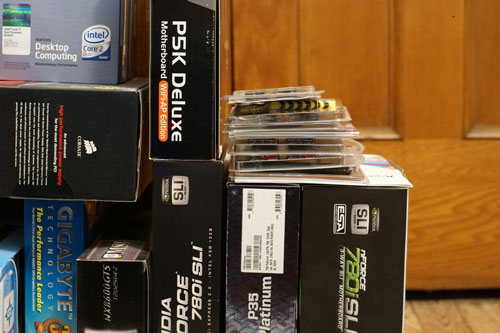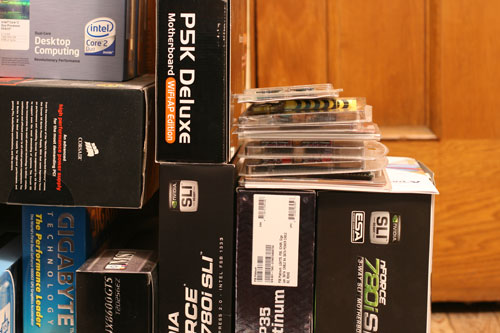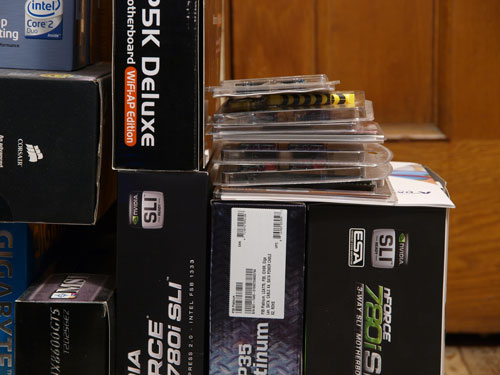The Digital Sensor: A Guide to Understanding Digital Cameras
by Wesley Fink on April 21, 2008 1:00 AM EST- Posted in
- Digital Camera
Field of View
Now that you have some basic understanding of digital camera sensors, it is time to take a closer look at the practical considerations that are created by these differences in sensors. A very poorly understood concept is the lens multiplier with the smaller than 35mm sensor-size that is used in most digital SLR cameras. The best way to illustrate this is with actual photos taken by a range of digital SLR cameras from the same tripod location.
We shot the same view using the exact same tripod location on a range of current digital SLR cameras. Each camera used a lens with the same focal length of 50mm. Lighting was the same with a 100W high-right light source, camera aperture was f4.0 in all cases, and white balance was set to Tungsten. The purpose of this series is to illustrate what you can see with each camera with the same lens, so exposure data is somewhat irrelevant, but exposure conditions were kept as constant as possible for reference.

The Canon EOS 5D is a full-frame SLR, which means the sensor is the same size as 35mm film. This point of view is the way an image at this distance would look on the Nikon D3, Canon 1Ds III, Canon 5D, and 35mm film cameras. The APS-H sensor used in a few Canon pro models is 1.3X and falls between full frame and 1.5X in its field of view.

The 1.5X multiplier is typical of cameras based on the Sony and Samsung sensors. This includes the Sony A700/A350/A300/A200/A100, the Nikon D300/D200/D80/D60/D40x/D40, the Pentax K20D/K10D/K200D/K100D, and all Samsung digital SLRs.

Canon introduced the small APS C sensor in the pioneering D30 and they have kept this size for consumer cameras since. This field of view is typical of the Canon 40D/XTi/XSi. The Foveon sensor Sigma SD14 has a 1.7X lens multiplier and falls between this small APS C Canon sensor and the 4/3 system.











72 Comments
View All Comments
gheinonen - Tuesday, October 14, 2008 - link
I am curious why that CMOS sensor in the high end Canon camera body has excellent low black noise compared to the images from a Fuji Pro S3/S5 with its Super CCD? I have used Fuji Pros since 2004 and have discovered that my black details in low light situations include a lot of random color noise which I do not see when reviewing images from the 1DS Mark2 body. What does the Canon body do to eliminate the random color noise in low light black detail? Is it the CMOS Sensor? Is it the body processing?Separately, the white detail on my Fuji Pro S3 has such expanded dynamic range that I can shoot higher exposures and then lower the exposure back to normal in software and it appears to lower or mask the noise floor in the same way that Dolby Noise Reduction works for audio.
bonedaddy - Wednesday, April 30, 2008 - link
I've been a 35 mm fan for years, and have a significant investment including multiple lenses, macro, ring lights etc. For trips etc the smaller cameras seemed fine--always had small 35 mm, for instance. However, re the digital small cameras, the amount of compression is really disappointing.Is my only choice to go back to a body/lens SLR if I want wide angle and telephoto capability AND good resolution?
Midwayman - Thursday, May 1, 2008 - link
No. But if you want wide/tele and really good high iso performance a SLR is where you need to be. PS camera have alway been a compromise. Small 35mm film cameras had focus issues, and lens issues too. Plus most people use iso 200-400 film which has reasonable quality even in a PS digital camera. The biggest difference is now we're blowing up the picture to 1:1 on our monitors and can see the quality defects easily. I bet if you printed your old compact photos at something like 16x20 you'd probably be unhappy with them too. That's the sort of scale we're looking at on our monitors zoomed in.CyniCat - Thursday, April 24, 2008 - link
Good article, but one glaring mistake: you claimed Sony was the first to make a 12+Mpixel CMOS sensor. I think you meant the first AFTER Canon - the 5D, with its 12.8Mpixel sensor, was on the market in 2005, and the 1Ds Mark II, with a 16Mp sensor, was on the market earlier than that.On a different front, I thought the Nikon D3 was using a Sony sensor, not a Nikon?
Wesley Fink - Friday, April 25, 2008 - link
The 5D and 1Ds II and III are full-frame sensors. The Sony was the first consumer (read affordable) APS-C sensor. Canon now has their own 12 megapixel consumer sensor in the XSi, which we are now reviewing.Nikon did their own designs for the D3 sensor, but they do not, to our knowledge, have the capabilities to manufacturer that sensor. Sony has manufactured sensors for them in the past and present with the D300, D60, D80, and others.
Since the new full-frame is CMOS it is likely manufactured by Sony, or possibley Samsung. Sony and Samsung (who make the Pentax 14.6 megapixel sensor) jointly own several patents on CMOS manufcaturing technology.
Wesley Fink - Friday, April 25, 2008 - link
That should read the read "First consumer 12 megapixel APS-C sensor". As mentioned several times in the article Canon pioneered CMOS technology in a consumer DSLR with the Digital Rebel.Midwayman - Wednesday, April 23, 2008 - link
This article complete skips of fuji's fantastic super CCD technology. Its not really a traditional Bayar array, nor a foveon. True they don't produce a interchangeable lens SLR but they do make prosumer SLR's with their sensor. Also the very notable fuji f30 series cameras were made with this sensor. It was a true triumph in PS camera high iso usability.ElFenix - Thursday, April 24, 2008 - link
fuji makes interchangeable lens SLRs with Nikon F mounts.Midwayman - Friday, April 25, 2008 - link
Hell, then there is no excuse for it not to be included in this article. Especially when it quite clearly states there are no other sensor options at one point.Wesley Fink - Friday, April 25, 2008 - link
There will always be fans of one technology or another who feel slighted. I apologize for that, but Fuji is still basically a Bayer sensor with a differnt pixel shape. I have added the following to the Bayer vs. Foveon page to make Fuji fans a bit happier:"FujiFilm produces one current DSLR with a variant of Bayer technology. It is called the Fuji S5 Pro and is basically a Nikon D200 body with a Fuji Super CCD sensor. The Fuji S5 Pro uses the Nikon lens mount. The Super CCD still uses red, blue and geen pixels in the same standard Bayer ratios. However, the shape of the pixel is hexagonal rather than the squate or rectangular pixels in other Bayer arrays. In the latest version Fuji also added smaller photosites between the normal pixels to gather "dynamic range" data.
Fuji has updated the camera body from the S3 to the S5 in the past year, but the sensor has not been updated for more than 3 years. The current Super CCD is still a 6.3 megapixel sensor, but Fuji specifes it as a 12.3 megapixel due to the addition fo the tiny "brightness" pixels. Tests indicate the true resolution is more comparable to an 8 to 10 megapixel sensor from competitors. The Fuji sensor is still basically a Bayer sensor with a different shape for pixels."
We can probably now all argue whether the Fuji Super CCD is really a Bayer variant or not. It certainly appears that way to me, and as a CCD instead of a CMOS sensor it is need of a serious update if it is to continue as a player in the DSLR market.